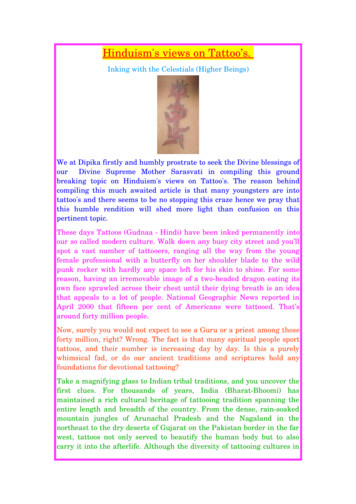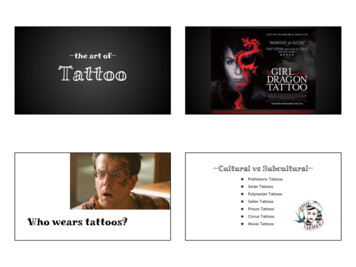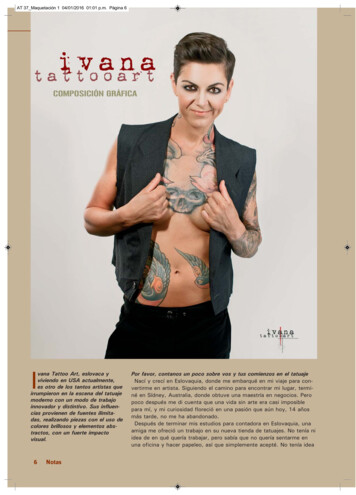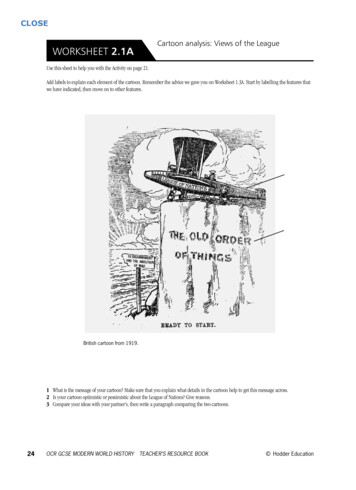
Transcription
Hinduism's views on Tattoo’s.Inking with the Celestials (Higher Beings)We at Dipika firstly and humbly prostrate to seek the Divine blessings ofour Divine Supreme Mother Sarasvati in compiling this groundbreaking topic on Hinduism's views on Tattoo's. The reason behindcompiling this much awaited article is that many youngsters are intotattoo's and there seems to be no stopping this craze hence we pray thatthis humble rendition will shed more light than confusion on thispertinent topic.These days Tattoos (Gudnaa Hindi) have been inked permanently intoour so called modern culture. Walk down any busy city street and you’llspot a vast number of tattooers, ranging all the way from the youngfemale professional with a butterfly on her shoulder blade to the wildpunk rocker with hardly any space left for his skin to shine. For somereason, having an irremovable image of a two headed dragon eating itsown face sprawled across their chest until their dying breath is an ideathat appeals to a lot of people. National Geographic News reported inApril 2000 that fifteen per cent of Americans were tattooed. That’saround forty million people.Now, surely you would not expect to see a Guru or a priest among thoseforty million, right? Wrong. The fact is that many spiritual people sporttattoos, and their number is increasing day by day. Is this a purelywhimsical fad, or do our ancient traditions and scriptures hold anyfoundations for devotional tattooing?Take a magnifying glass to Indian tribal traditions, and you uncover thefirst clues. For thousands of years, India (Bharat Bhoomi) hasmaintained a rich cultural heritage of tattooing tradition spanning theentire length and breadth of the country. From the dense, rain soakedmountain jungles of Arunachal Pradesh and the Nagaland in thenortheast to the dry deserts of Gujarat on the Pakistan border in the farwest, tattoos not only served to beautify the human body but to alsocarry it into the afterlife. Although the diversity of tattooing cultures in
India is great, the literature on the subject is surprisingly rare outside ofobscure university and governmental reports, not to mention early 20thcentury census pamphlets buried in dusty archives and museumlibraries. Aside from these issues of access, the contemporaryethnographic records are relatively weak on the art form itself. This canbe attributed to the fact that most of India's tattooed tribes have dwelledin remote hinterlands until recently and have long been suppressed,forgotten, and/or discriminated against for their refusal to discard theirtribal practices like tattooing that seemed uncivilized and unimportantin comparison to more urban, modern, and sophisticated culturallifestyles in the cities.Also certain tribes believe that Lord Raam’s greatest devotee, The greatestsuperhero this earth ever seen Shree Hanumanji, can be tattooed on arecurring dislocating shoulder to relieve the pain. The women of the nomadicRibari tribe of Kutch in North West India, one of the places the Pandavasvisited during their exile, have many profoundly elaborate tattoos. And theRamnami community, scattered across the Indian states of Bihar and MadhyaPradesh, began a painful custom in the nineteenth century: they had the nameof Lord Raam in Sanskrit tattooed on practically every inch of skin, even ontheir tongues and inside their lips. This practice was meant to protect themfrom bigoted caste conscious brahmanas they had angered by adoptingBrahminical customs, and is still carried on today.Tattoo ing in India is considered to be an ancient custom, but just how old it isremains a mystery. One clue to its apparent antiquity may be found incomparing petroglyph (rock engravings) designs of labyrinths to tattoos ofsimilar design. For example, a recently discovered rock art site tentativelydated to 2500 BCE, on a riverbank at Pansaimol, Goa, West India, portrays alabyrinth cut into a stone (Fig. 1). Another labyrinth dated to 1000 BCEinscribed on a dolmen shrine at Padugla in the Nilgiri Hills reveals a similarconfiguration (Fig. 2). Do note that 2500 BCE already pre dates major worldreligions of today like Christianity and Islam by quite a period. But of coursewe won't get into that now (we shall save that for a future mouth wateringarticle).Figure 1Figure 2
Many South Indian tattoo designs worn around the early 20th centurywere specifically derived from kolam (magical devices) patterns becausethey were also believed to be protective in nature (Fig. 3). These complextattoos were a puzzle, since Lord Yamaraja, the Deity of Death, and theYamadutas (the servants of Lord Yamaraja) could not harm the tattooedsince they could not solve the puzzle that the tattoos presented. Why?Because kolam tattoos were a maze with the idea that demons weredrawn into the pattern, then lost, and rendered powerless. At the sametime, however, kolam markings were also connected to other aspects ofthe afterlife. Among so called “lower castes and tribes”, it was considereda necessity for women, and some men, to be tattooed in order to avoidpunishment in the land of the dead, because Lord Yamaraja's servantsonly devoured the unmarked. Kolam tattoos also worked as a kind ofmap because they were believed to help guide the dead person on theirway to the land of the dead (Pitr loka) so that they would be safelyreunited with their deceased ancestors. There is a common belief acrossIndia that tattoo marks migrate to Heaven with "the little entire man orwoman (soul)" inside the mortal frame. In other words, it's believed thatif there is anything that survives after death it's the tattoo marks,because the soul is identified by them.Figure 3From the warrior tattoos of the Naga, to the magical kolam markingsand tattoos of the Hindu pantheon, India's tattoo cultures comprise anincredibly rich tribal mosaic of visual artistry spanning thousands ofmiles and thousands of years. Here vestiges of indigenous tattooingpractices still survive in forms close to their original sources, eventhough modernity and other influences have set in motion a series oftransformations that may perhaps lead to the eternal demise of theseancient traditions.Many cultures regard tattoos as protective amulets, and such magicalapplications are closely linked to religious beliefs. The Ainu women inJapan, for instance, tattoo themselves with images of their Goddess,which is able to repel evil spirits and thus protect from disease. The
Iraqis commonly tattoo a dot at the end of a child's nose to guard againstillness. The Aborigines in Australia believe tattoos on their arms allowthem to dodge boomerangs. The soldiers in Burma tattoo their thighs tobe invulnerable in war, and the Cambodian men cover themselves intattoos to make themselves impervious to harm, even from bullets. Theuse of tattoos in Cambodia may have come centuries ago from Indiansettlers who practised Vedic rituals. Sacred Buddhist texts are afavourite tattoo in Thailand, where they are believed to have magicalpower. In an initiation rite known as the "Krob Kru," the devotee lightsincense and prays in preparation. The tattoo artist uses a special rod toinscribe the sacred text on the chest, back or arms. A shaman then teststhe tattoo's potency by giving each tattoo three or four strong swipes of asword. Tattoo recipients often enter a state of ecstasy or burst intoviolent trances. Like most of the Pacific Islands, Samoa also has a veryrich tattoo tradition. In ancient Samoa, tattooing played an importantrole in both religious ritual(s) and warfare. The tattoo artist held ahereditary and privileged position. He customarily tattooed young menin groups of six to eight, during a ceremony attended by friends andrelatives who participated in special prayers and celebrations associatedwith the tattooing ritual. The tattoos of Pacific Islands natives made animpact on English explorers notably those who sailed with CaptainCook late in the 18th century and they returned home with bold newdesigns and helped resurrect the tattoo art in Europe.But so far, it's rather tribal and certain serious spiritual practitionerswill need more tangible scriptural endorsement before they startinjecting ink into their skin.Of course, the modern incarnation of tattooing wasn’t around during orbefore the birth of Gaudiya Vaishnavism (A path followed by devotees ofLord Vishnu), but there are close parallels. In the Prameya Ratnavali,the 18th century Gaudiya Vaishnava commentator Srila BaladevaVidyabhushana cites five purificatory processes (panca samskara) that,along with spiritual initiation, bring one direct perception of LordKrishna, viz. Austerity, Wearing Tilaka, Performing Sacrifices,Accepting a new name at initiation, and Chanting mantras glorifying theSupreme Lord. Srila Baladeva’s elaboration is surprising: “In this verse,the word “austerity” means to accept the branded marks of Lord Vishnu:the disc, lotus, conch, and mace” (depicted in the picture below) — {thevery images I have on my body}. Like tattooing, branding is permanent,and yes, very painful.
The drawing above is from the Pancaratra Pradipa Vol One page 41,(Method of Deity Worship) GBC Press Deity Worship.A tradition that goes back to at least 1017 C.E., it's still practised todayby followers of both Madhvacharya and Ramanujacharya Sampradayas,mainly in the South Indian states of Karnataka, Tamil Nadu, Kerala,and Andhra Pradesh. What’s more, for Sri Vaishnavas and Ramanuja’sfollowers, it’s an essential part of the initiation process.Picture this: It’s morning, and the air is cool. As the sun rises behind youand the birds start to twitter, your heart beats fast but you sit quietly,staring at the blazing sacrificial pit in front of you. A married priestperforms the Havan (Yajna fire ceremony). Offering oblations into thefire, he invokes the Ayudha Devatas, the personified forms of LordVishnu’s sacred weapons. Metal stamps in the traditional shape of eachweapon are then attached to metal poles and held within the dancingflames. After some time, your guru takes them and taps them on a plate.You watch, knowing that this is to make sure no loose pieces of hotcharcoal come off on your skin. Finally, he begins to chant the mantrafor Sudarshana, Lord Vishnu’s discus. It’s time. You tense. You feel thered hot brand press against your right shoulder, burning, stinging. Thenthe Pancajanya mantra is chanted, and the symbol of Vishnu’s conch shell is branded on your left shoulder. You sigh. It’s over. You are nowready for the rest of your initiation ceremony. Fortunately for us, ShreeChaitanya Mahaprabhu and the Acharyas in His line haverecommended that one use tilaka clay instead of branding to drawVishnu’s symbols on the body. So if you’re on the list for spiritualinitiation, no need to scream and run—no Gaudiya Vaishnava guru willtry to press a red hot iron pole against your arm during the ceremony.
The Shankha (Conch)Branding gets its fair amount of exposure in our traditions andscriptures. But it’s tilaka that Shree Chaitanya Mahaprabhu’srecommended as an alternative, that presents our closest parallel totattooing. Every Gaudiya Vaishnava is aware of the virtues of wearingtilaka, or sacred clay. The “u shaped” mark and oval worn on theforehead is one of their most instantly recognizable symbols. But whatyou may be surprised to learn is that Vaishnava scriptures also containinstructions to write the holy names with tilaka—and even to drawpictures on the body with it. In Bhakti rasamrita sindhu, which containsthe complete science of Bhakti Yoga, Srila Rupa Goswami Maharaja tellsus, “In marking such tilaka, sometimes one may write “Hare Krishna”on the body.” And then in the same book, he quotes the Skanda Puranaon a benefit of wearing tilaka: “Persons whose bodies are marked withtilaka, symbolizing the conch shell, chakra, club, and lotus even seenonce, can help the seer be relieved from all sinful activities.”In the Hari Bhakti Vilasa, compiled by Srila Sanatana Goswami, hestates that Lord Vishnu mentions: “I enter within the hearts of thosedevotees who, in the age of Kali Yuga, decorate their bodies withdrawings of My incarnations, such as Matsya and Kurma Those whowear the drawings of My incarnations on their bodies are not ordinaryhuman beings—they exist on the same platform as My incarnations.”Discussing the subject in great detail, the Hari Bhakti Vilasa continuesto enforce its point for over fifty verses, even going so far as to suggest,“If a fallen brahmana does not decorate his body with tilaka, as well asdrawings of a conch shell and disc, then the king should put him on theback of a donkey and drive him out of his kingdom.”Fair enough. But as you’re spurring your donkey on into the sunset, youmay want to ask, “Is all of this really that important?” Well, the greatVaishnava Acharya Srila Bhaktivinoda Thakura certainly had anopinion. In his 1885 essay Pancha Samskara: The Process of Initiation,he discusses the five purificatory processes from Prameya Ratnavalimentioned earlier in this article, two of which are tapa (defined by SrilaBaladeva Vidyabhushana as branding) and wearing tilaka markings.
Yes, he acknowledges them as prescribed ways to sanctify oneself so thatone’s true spiritual nature can develop. But far more forcefully, hecondemns being concerned only with the external: “Tapa applies not onlyto the body, but also to the mind and the soul. If it's only physical, in theform of branding or stamping, then tapa has not actually taken placeand religious practice becomes hypocritical.” He continues emphasizingthe hollowness of such an approach: “Externally the student looks good,but internally there is nothing. The symbols of divine conch, disc, andthe name of Lord Hari [Lord Krishna] mark the body. The tongue uttersthe name of Lord Hari, and worship of Shalagrama Shila (a small blackstone that is worshipped as non different from the Supreme Lord) or thedeity with mantra is performed, but the student is a
designs and helped resurrect the tattoo art in Europe. But so far, it's rather tribal and certain serious spiritual practitioners will need more tangible scriptural











